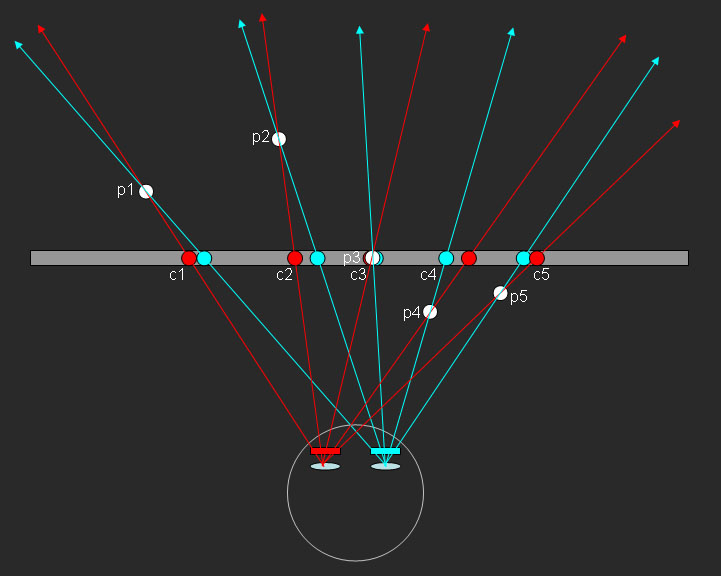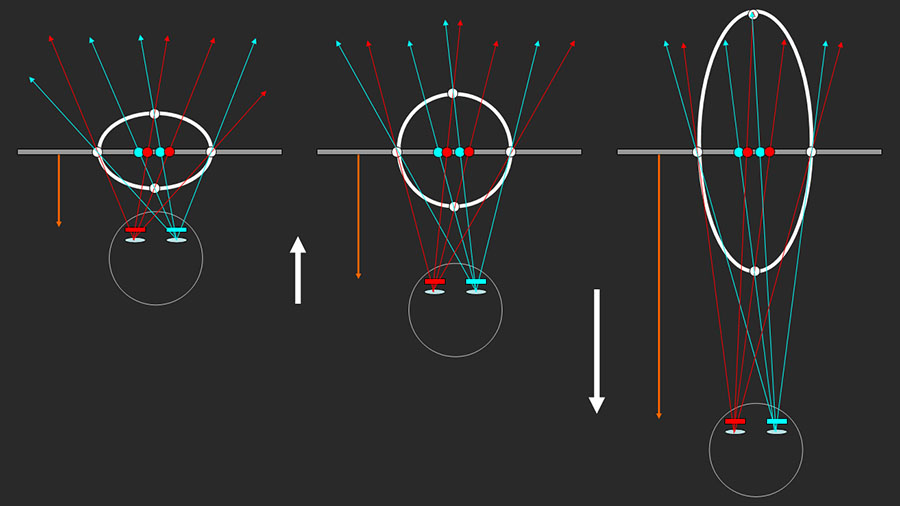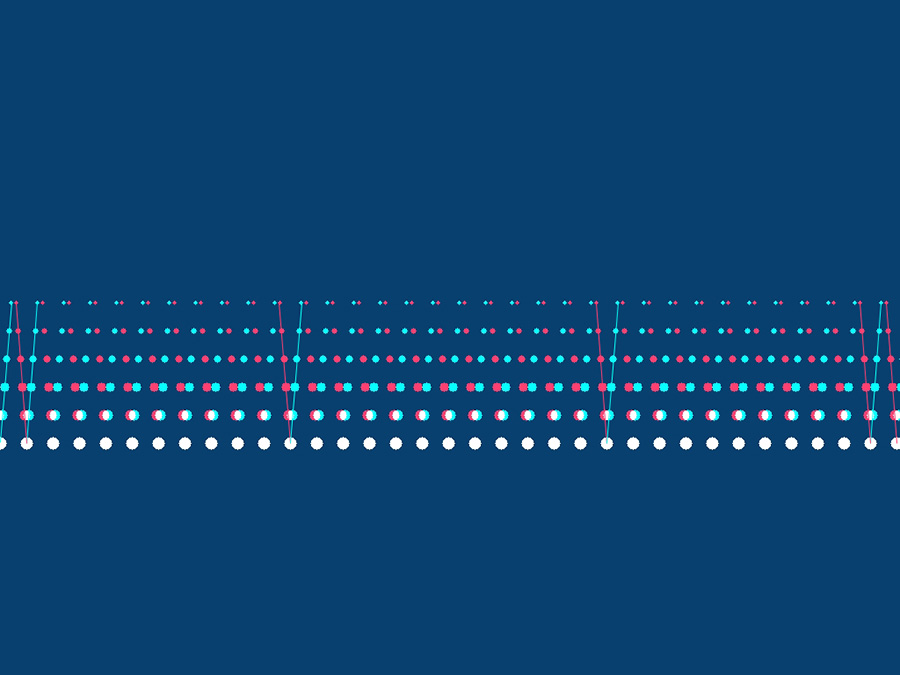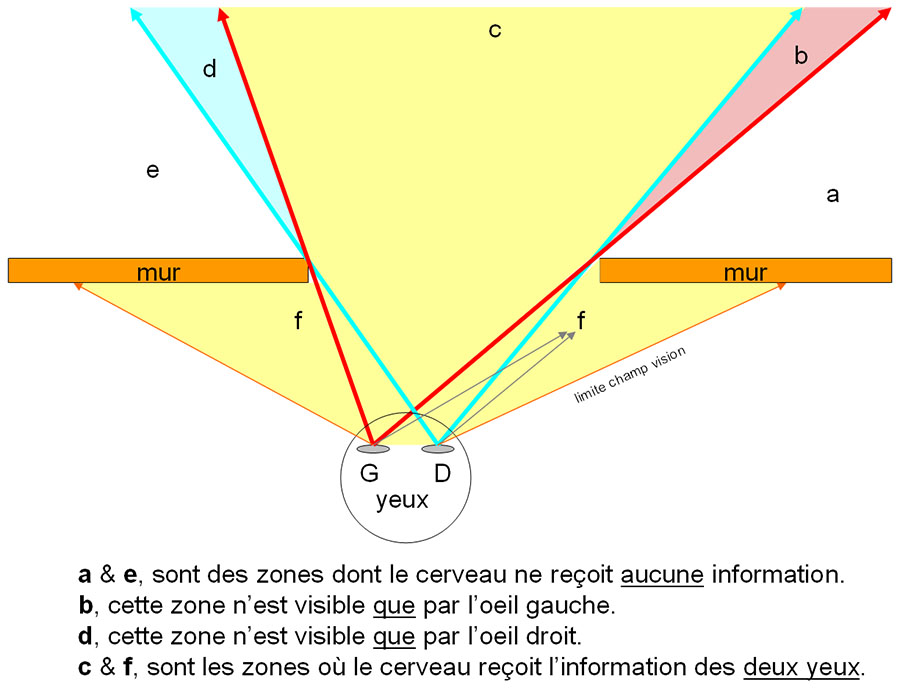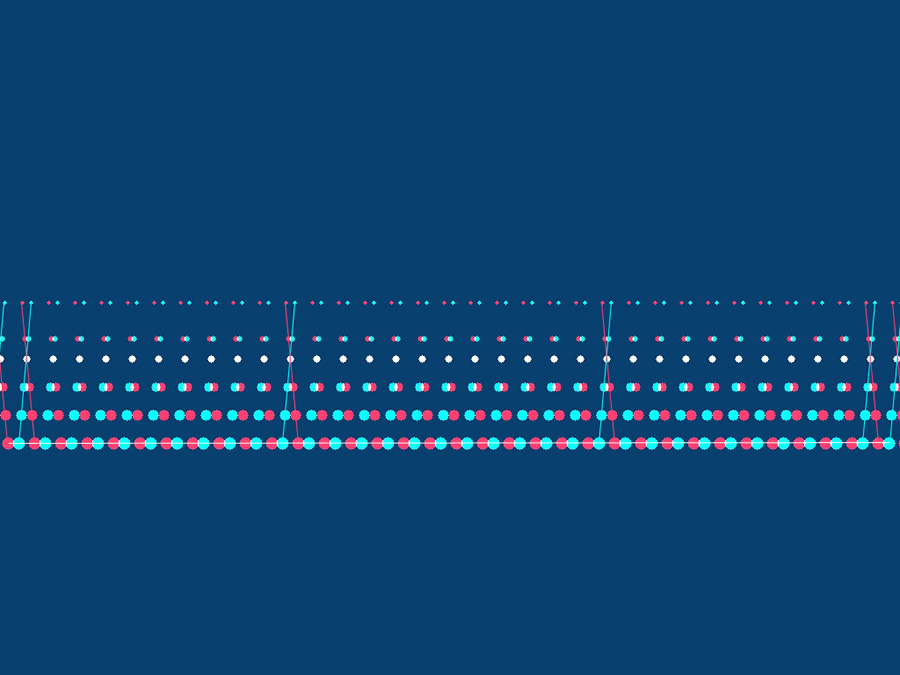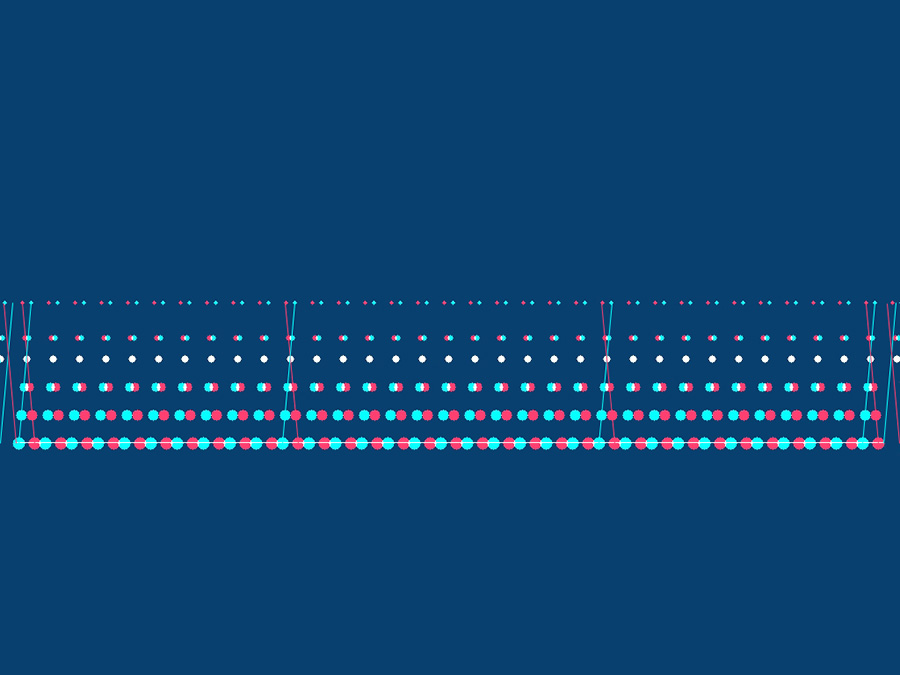Available volume in front of and behind the screen
Anaglyph carried out by a personal software
height 700 pixels, width 1024 pixels
Why do you see depth and a volume starting from the couples of points and lines?
Depth Formation of a stereoscopic image:
The illustration (A) schematizes the experiment which you have just lived by observing the preceding anaglyph. On bottom, you, the observer, your eyes and the coloured filters of the glasses (red to inject the image of left, cyan to inject the image of straight line in your brain). In the medium, the screen seen of top, the image, couples of discs which you see red and cyan without glasses and which become white (blanc=rouge+cyan) with the anaglyph glasses. 5 stereoscopics couples of disc are represented on the image c1, c2, c3, c4 and c5. These couples are seen with the anaglyph glasses like white discs located at different depths p1, p2, p3, p4 and p5 because the distance/shift which separates them and their order is different. Indeed, the white discs are perceived on the level of the intersection of the directions of the lines of concerned each component. The command of the colors varies the position behind or in front of the screen. The distance which separates them varies the depth or the gushing.
- if the couple then does not have a shift the disc is perceived in the plane of the display screen (c3 and p3 is confused);
- c1 and c2 are perceived with far because the lines of aimed cross behind the screen, the red component is on the left of sound homolgue cyan. p2 is further perceived than - p1 because the shift c2 of its components red and cyan is more important than that of c1;
- p4 and p5 are perceived in front of the screen, in gushing, because the lines of aimed cross in front of the screen, the red component is on the right of the cyan. p4 is perceived nearer than p5 because the shift c4 of its components red and cyan is more important than c5;
Reconsider after these explanations the preceding image for better understanding than you observed. The demonstration is simpler by using an anaglyph but the other processes of projection relief function in the same way.
Illustration A
Depth formation of a stereoscopic image, example with anaglyph
width 720 pixels, width 1100 pixels
Why ideal observation position ?
The illustration (B) schematizes the effects of the position variation of anaglyph observation (seen top):
- In the center, an observer with its glasses observes an anaglyph which represents a quasi transparent white sphere (a soap bubble). This anaglyph is assembled to place the sphere in a way balanced in front of and behind the screen (the gray rectangle). She is seen correctly with the good proportions, it is the orthostereoscopic position;
- On the left, the observer approaches the screen, the lines of aimed do not have any more the same directions and the sphere is crushed. One crushes the relief while approaching the screen. There is even a position limits extreme proximity from which the brain does not perceive any more fuzzy depth but two images;
- On the line, the observer moves away from the screen, the lines of aimed do not have any more the same directions and this oblong sphere in the direction depth. It is deformed but one artificially increases the feeling of relief and depth. For example, for an anaglyph of the Moon or Sun, these two stars will appear more in relief because one thus increases the distance perceived between the edges and the center of the apparent disc.
Illustration B
The ideal position of observation of a quasi transparent ball (in the center)
on the left, the observer advances and crushes the sphere
on the line, the observer moves back and oblong the sphere with a larger feeling of depth but deforming
width 900 pixels, width 1200 pixels
The effect is identical if the object is placed behind the screen:
Illustration C
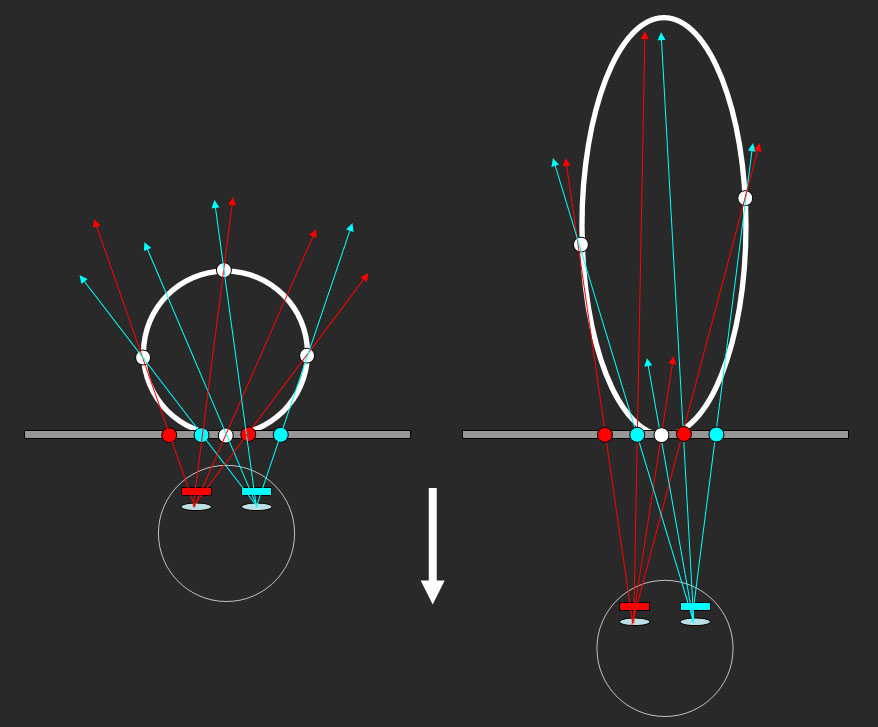
Assembly simulation of a plane :
This first example of assembly is known as with the window (limit of the image on the screen in this case):
The angular shift between the two shoot of right sight and left introduces a parallax p. the effect of the parallax is visible below by the horizontal shift of each disc and the angle between the two segments of straight line which are seen like a direction line by observing it with glasses for anaglyph. This shift is more or less important with the depth of the objects of the scene but the angle of parallax is the same one for all image disks. For the assembly called to the window, the stereo couple is aligned so as to have only the red component (left eye) on the left of the component cyan (right eye). Thus all the discs below are perceived behind the screen. With the glasses for anaglyph, one perceives the first ahead coplanar discs with the screen. They do not have a shift of the components left and right. Thus one can identify this particular plane in a stereo image, there or the anaglyph seems not shifted. It is very important to notice that on the edges left and right it misses, on the discs in edge, respectively left information (red) and straight line (cyan) without any gene of visualization for the brain because masked objects are treated with no problem :
Assembly 1 (known as with the window)
the plane assembly to the window
Anaglyph carried out by a personal software
width 900 pixels, width 1024 pixels
Why ?
We are in fact in a normal situation life in binocular vision illustrated by the diagram below (an observer seen of top, in front of a gate or a window of frontage). The wall represented is in fact the image limits (known as the window) on your screen of computer. The areas d and b are seen only one eye by the brain. The brain receives only the information of one eye and it is not disturbed because the situation is natural and usual. On the other hand, now try to imagine what can occur in areas f and c if one artificially removes one of the components straight line or left, where the brain is naturally accustomed to receive the information of the two eyes ? Will it be found there ? Also note that in the case of the observation through a limit, this problem with the left parts and straight line of the wall do not exist with the parts high and low because our eyes are with the same height and thus there is no angular shift of perception, not of parallax and thus not of area d and b on the bottom and the top of the gate or window of frontage:
Illustration D
visible areas naturally in front of a gate or a house window
width 900 pixels, width 1225 pixels
In the assembly called “to the window”, the objects are generally located behind the display screen but we can approach the stereo window (floating window). Now let us try to bring them closer to see them more closely and use available volume in front of the screen.
1 - below: The assembly of the same preceding plane with the same parallax p but by approaching it the observer, placed in front of and behind the limits image (f) (c). The goal is to use all available volume for the relief vision and to bring closer the objects to the observer. On this second assembly not optimized, it is possible that you perceive an embarrassment/vibration on the edges or quite simply which you do not manage to locate before plane. Indeed, contrary to the preceding situation, according to the individual, the brain is more or less sensitive to the surplus information when the object is located in gushing, in front of the window. As shows it the preceding illustration, in binocular vision, it is not natural that the brain perceives information in more or in less for one object located in areas (f) and (c). In assembly 2, on the left edge, the last red disc is not associated with its correspondence cyan because it is out of the limits of the image, it is not visible and nonrepresentable. Thus the brain has the information of the image of left (red) but not the image of straight line (cyan). The brain does not know where to locate it because it has information image of left (red) in excess. This red zone should be masqued but the masq is not visible. It is said that there is a window violation. With glasses, one observes even a curvature of the limiting lines on the edges. Idem on the line but in a less marked way because a piece of the red disc is visible, the brain knows better where to locate it kind. According to the scene, the image, the individual who observes, this problem is more or less sensitive :
Assembly 2 (not optimized)
The same plane assembly in front of the window without optimized work, there is a window violation
Anaglyph carried out by a personal software,
width 900 pixels, width 1024 pixels
2 - below : The assembly always of the same plane but with a optimized reframing work on the edges left and right. Optimization consists in removing the noncommon parts between the components left (red) and right-hand side (cyan), for the points/pixels/objects which are placed in front of the screen in gushing. In other words, for the objects in front of the window, one should leave in the stereo image only the pixels which have a solution in the two components left and right-hand side, the homologous points. In this assembly 3, there is no window violation and one can thus use all available volume, to bring closer the objects to the observer. One observes the object directly, without having the impression to look it since a window or a frame held in front of the head. One is immersed much more in the image. Don't you tend to approach you when you look by the window of a house ? You seek to increase the visible field…
Notice the limits on the edges, the form and dimension of the cut to be realized is function of the parallax and the various positions of the spouting out objects. In the anaglyph case, it can be also interesting to use this technique to limit the ghosts by balancing the red shift and cyan compared to the plane of the screen. Move the mouse on the anaglyph to locate in-depth window. Move to the screen (10 cm) and move back (2 m) to perceive the ideal position and its limits :
Assembly 3 (optimized)

